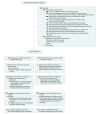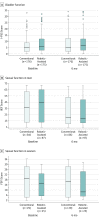Effect of Robotic-Assisted vs Conventional Laparoscopic Surgery on Risk of Conversion to Open Laparotomy Among Patients Undergoing Resection for Rectal Cancer: The ROLARR Randomized Clinical Trial
- PMID: 29067426
- PMCID: PMC5818805
- DOI: 10.1001/jama.2017.7219
Effect of Robotic-Assisted vs Conventional Laparoscopic Surgery on Risk of Conversion to Open Laparotomy Among Patients Undergoing Resection for Rectal Cancer: The ROLARR Randomized Clinical Trial
Abstract
Importance: Robotic rectal cancer surgery is gaining popularity, but limited data are available regarding safety and efficacy.
Objective: To compare robotic-assisted vs conventional laparoscopic surgery for risk of conversion to open laparotomy among patients undergoing resection for rectal cancer.
Design, setting, and participants: Randomized clinical trial comparing robotic-assisted vs conventional laparoscopic surgery among 471 patients with rectal adenocarcinoma suitable for curative resection conducted at 29 sites across 10 countries, including 40 surgeons. Recruitment of patients was from January 7, 2011, to September 30, 2014, follow-up was conducted at 30 days and 6 months, and final follow-up was on June 16, 2015.
Interventions: Patients were randomized to robotic-assisted (n = 237) or conventional (n = 234) laparoscopic rectal cancer resection, performed by either high (upper rectum) or low (total rectum) anterior resection or abdominoperineal resection (rectum and perineum).
Main outcomes and measures: The primary outcome was conversion to open laparotomy. Secondary end points included intraoperative and postoperative complications, circumferential resection margin positivity (CRM+) and other pathological outcomes, quality of life (36-Item Short Form Survey and 20-item Multidimensional Fatigue Inventory), bladder and sexual dysfunction (International Prostate Symptom Score, International Index of Erectile Function, and Female Sexual Function Index), and oncological outcomes.
Results: Among 471 randomized patients (mean [SD] age, 64.9 [11.0] years; 320 [67.9%] men), 466 (98.9%) completed the study. The overall rate of conversion to open laparotomy was 10.1%: 19 of 236 patients (8.1%) in the robotic-assisted laparoscopic group and 28 of 230 patients (12.2%) in the conventional laparoscopic group (unadjusted risk difference = 4.1% [95% CI, -1.4% to 9.6%]; adjusted odds ratio = 0.61 [95% CI, 0.31 to 1.21]; P = .16). The overall CRM+ rate was 5.7%; CRM+ occurred in 14 (6.3%) of 224 patients in the conventional laparoscopic group and 12 (5.1%) of 235 patients in the robotic-assisted laparoscopic group (unadjusted risk difference = 1.1% [95% CI, -3.1% to 5.4%]; adjusted odds ratio = 0.78 [95% CI, 0.35 to 1.76]; P = .56). Of the other 8 reported prespecified secondary end points, including intraoperative complications, postoperative complications, plane of surgery, 30-day mortality, bladder dysfunction, and sexual dysfunction, none showed a statistically significant difference between groups.
Conclusions and relevance: Among patients with rectal adenocarcinoma suitable for curative resection, robotic-assisted laparoscopic surgery, as compared with conventional laparoscopic surgery, did not significantly reduce the risk of conversion to open laparotomy. These findings suggest that robotic-assisted laparoscopic surgery, when performed by surgeons with varying experience with robotic surgery, does not confer an advantage in rectal cancer resection.
Trial registration: isrctn.org Identifier: ISRCTN80500123.
Conflict of interest statement
Figures


Comment in
-
Robotic-Assisted Surgery: Balancing Evidence and Implementation.JAMA. 2017 Oct 24;318(16):1545-1547. doi: 10.1001/jama.2017.13696. JAMA. 2017. PMID: 29067404 No abstract available.
-
Surgery: Robotic assistance confers no benefit in rectal cancer surgery.Nat Rev Gastroenterol Hepatol. 2017 Dec;14(12):690-691. doi: 10.1038/nrgastro.2017.160. Epub 2017 Nov 8. Nat Rev Gastroenterol Hepatol. 2017. PMID: 29114102 No abstract available.
-
Robotic-Assisted vs Conventional Laparoscopic Surgery for Rectal Cancer.JAMA. 2018 Mar 20;319(11):1163-1164. doi: 10.1001/jama.2017.21692. JAMA. 2018. PMID: 29558546 No abstract available.
References
-
- Bonjer HJ, Deijen CL, Abis GA, et al. ; COLOR II Study Group . A randomized trial of laparoscopic versus open surgery for rectal cancer. N Engl J Med. 2015;372(14):1324-1332. - PubMed
-
- Jeong SY, Park JW, Nam BH, et al. . Open versus laparoscopic surgery for mid-rectal or low-rectal cancer after neoadjuvant chemoradiotherapy (COREAN trial): survival outcomes of an open-label, non-inferiority, randomised controlled trial. Lancet Oncol. 2014;15(7):767-774. - PubMed
-
- Stevenson AR, Solomon MJ, Lumley JW, et al. ; ALaCaRT Investigators . Effect of laparoscopic-assisted resection vs open resection on pathological outcomes in rectal cancer: the ALaCaRT randomized clinical trial. JAMA. 2015;314(13):1356-1363. - PubMed
-
- Pigazzi A, Luca F, Patriti A, et al. . Multicentric study on robotic tumor-specific mesorectal excision for the treatment of rectal cancer. Ann Surg Oncol. 2010;17(6):1614-1620. - PubMed
Publication types
MeSH terms
Associated data
Grants and funding
LinkOut - more resources
Full Text Sources
Other Literature Sources
Medical

